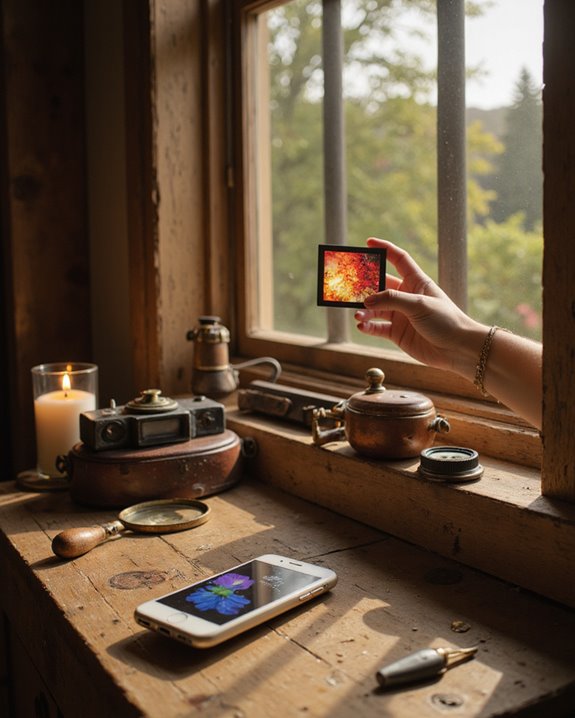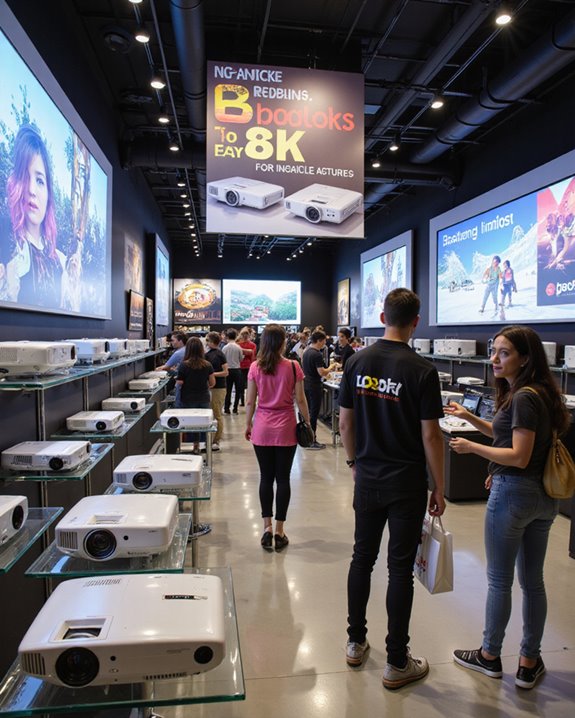Slides can be viewed without a projector by displaying them on digital screens, such as TVs, computer monitors, or tablets, using connections like HDMI or screen mirroring. Physical printouts, handouts, or posters provide tactile alternatives for audiences. Remote collaboration tools, including Zoom, Teams, or Google Meet, enable real-time viewing through screen sharing. Interactive displays and video formats further enhance accessibility. Each method offers distinct advantages in flexibility, clarity, and engagement, with more creative options and technologies available for exploration.
Key Takeaways
- Use digital screens like TVs, monitors, tablets, or smartphones to display slides via HDMI, wireless adapters, or screen mirroring.
- Share slides remotely with screen sharing tools such as Zoom, Microsoft Teams, or Google Meet for collaborative or virtual presentations.
- Print slide materials or handouts to provide tactile, physical copies for audience members to follow along without electronic displays.
- Incorporate interactive displays or augmented reality apps to view and interact with slides on personal devices or in physical environments.
- Convert slides into videos or animations and play them on any multimedia device for engaging, projector-free presentations.
Digital Screens and Interactive Displays
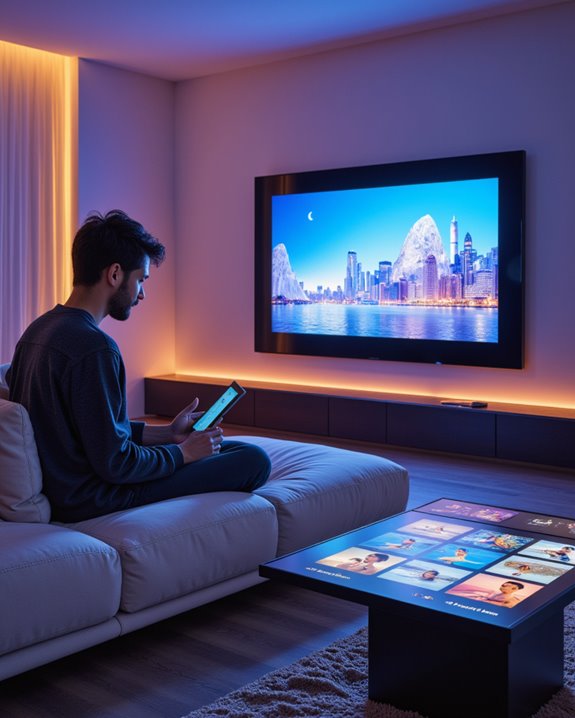
How can slides be viewed effectively without a projector? Digital screens and interactive displays provide a practical solution. These include flat monitors, tablets, smart TVs, and large digital signage boards. Digital signage, which displays dynamic content electronically, captures 400% more views than static displays and increases engagement by 94% compared to text. Augmented reality, which overlays digital content onto the real world using devices like smartphones or AR glasses, allows users to view slides interactively. Holographic displays, which project three-dimensional images in mid-air, offer immersive viewing without physical screens. Advanced technologies such as injected inks and reflective microfluidic displays ensure high-quality visuals and reduce environmental impact. In retail and public spaces, these solutions boost brand awareness, influence purchasing decisions, and deliver real-time information efficiently. Additionally, projection alternatives like virtual and mixed reality experiences are gaining popularity for engaging presentations. With the global digital signage market projected to reach $23.05 billion by 2025, adoption of these alternative display methods is expected to accelerate across industries.
Printed Slide Materials and Physical Handouts

Printed slide materials and physical handouts offer a reliable way to share presentation content without relying on technology. Printed handouts, which are paper copies of presentation slides or summaries, provide tactile interaction that can improve information retention. Audiences can take personal notes directly on physical slide materials, supporting active engagement. These materials act as lasting references, useful even after the event ends, and are essential in locations where digital devices are unavailable. For superior readability, printed handouts should use large, clear fonts and high-contrast colors, especially if printed in black and white. Designs should include slide numbers, concise titles, and dedicated space for notes. Common handout types include full-slide prints, outlines, summary sheets, worksheets, and supplementary diagrams or glossaries for added clarity. Using professional templates from online tools like Canva can help ensure printed materials are visually appealing and easy to read. Additionally, incorporating clear visual hierarchy in your layout can enhance understanding and focus.
Remote Viewing With Screen Sharing Tools

When in-person presentations are not possible, screen sharing tools provide a practical way to view slides remotely without the need for a projector. These tools are essential for virtual collaboration and remote presentations, allowing participants to share their computer screens in real time. Popular platforms include:
- Zoom: Shares entire screens or application windows, offers remote control, and records sessions.
- Microsoft Teams: Integrates screen sharing with chat, supports remote control, and enhances teamwork.
- Google Meet: Enables seamless sharing during video calls for effective group interaction.
- TeamViewer Remote: Provides secure, interactive access to troubleshoot or instruct.
- AnyDesk: Connects users via ID, supporting both desktop and mobile sharing.
Many modern screen sharing solutions, including TeamViewer, offer cross-operating system sharing without compatibility issues, making it easy for users on Windows, macOS, Linux, Android, or iOS devices to participate in slide presentations together. Features such as real-time interaction, remote control, session recording, and cross-platform compatibility ensure accessible, secure, and engaging slide viewing for professional and educational use. Additionally, leveraging remote desktop technology can facilitate more complex demonstrations and collaborative work environments.
Alternative Projection and Display Technologies
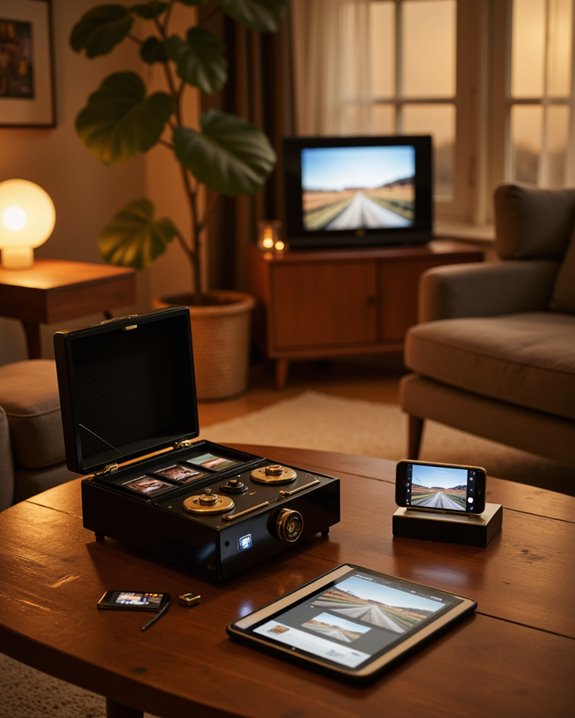
A wide range of alternative projection and display technologies now enables slide viewing without a traditional projector, offering flexibility for various environments and group sizes. Common options include:
- Television screens, which connect to laptops or phones using HDMI cables or wireless adapters.
- Laptop and desktop monitors, ideal for small-group presentations or dual-screen setups.
- Mobile devices, such as smartphones or tablets, that can display slides directly or mirror content to larger screens.
- Interactive flat-panel displays, which feature touch controls and smart functions for engaging presentations.
Compared to projectors, commercial displays provide brighter images, better resolution, and require less maintenance, making them a superior choice for classrooms and meeting spaces.
Emerging innovations include retinal projection, a technology that projects images directly onto the viewer’s retina, eliminating the need for physical screens. Even more futuristic are synaptic interfaces, which transmit visual signals straight to the brain. These technologies hint at a future where display hardware may become almost invisible.
Multimedia and Video-Based Slide Presentations
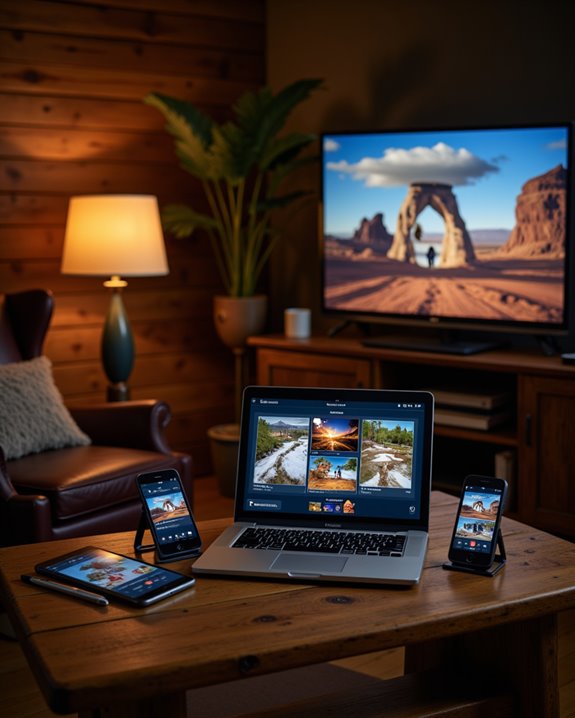
How can presenters share information without relying on a traditional projector? Multimedia and video-based slide presentations offer practical solutions. By integrating video clips, audio, and animations, presenters can enhance audience engagement. Popular software tools, such as PowerPoint and Google Slides, support multimedia integration and help maintain a consistent visual style. Presentations can be converted into slideshow videos with narration or background music, facilitating easy sharing for virtual collaboration—working together online. One key advantage of video presentations is that they make it easier to create a cohesive storytelling experience, engaging viewers more effectively than static slideshows.] Screen recording software and AI text-to-speech tools allow for clear, multilingual voiceovers. Augmented reality, or digital elements overlaid on the real world, can further enrich presentations. Key strategies include:
- Keeping text minimal for clarity
- Using interactive elements, like polls or quizzes
- Ensuring cross-platform compatibility for accessibility
These methods make presentations more flexible and accessible.
Visual Enhancements and Creative Presentation Formats

Although traditional projectors are common tools for sharing slides, presenters can achieve strong visual impact through alternative formats that do not require digital screens. Chalkboard sketches—drawings made in real time on a chalkboard—allow presenters to illustrate ideas clearly and adapt to audience feedback. Flip charts and whiteboards serve similar purposes, supporting spontaneous diagrams, flowcharts, or brainstorming sessions. Physical models, meaning tangible objects or prototypes, demonstrate key concepts by providing a hands-on, memorable reference. Printed handouts, including infographics or data charts, offer detailed information for immediate review and annotation. Creative spatial design, such as arranging posters or banners around the room, reinforces main points visually. These techniques, combined with expressive body language and vocal dynamics, ensure engagement and understanding without reliance on projected slides. Presenting without slides often grants the speaker more authority and audience attention, as listeners focus more intently on the ideas and delivery.
Frequently Asked Questions
How Can I Convert Powerpoint Slides to a Different File Format for Viewing?
To perform slide conversion, users can utilize PowerPoint’s export features or online tools to convert slides into various file formats such as PDF, JPEG, or MP4, enabling easier sharing, consistent formatting, and broader compatibility across devices.
What Are the Best Apps for Organizing and Storing Slide Decks?
When considering the best apps for organizing and storing slide decks, users often prioritize cloud storage and effective slide management. Google Slides, Canva, and Beautiful.ai stand out for seamless collaboration, customizable templates, and easy accessibility across devices.
How Do I Ensure Slide Readability in Brightly Lit Environments?
To guarantee slide readability in brightly lit environments, one should prioritize high slide contrast, choose light backgrounds, increase font size, and select clear fonts. Adjusting screen brightness and considering ambient lighting conditions further enhance visibility and audience comprehension.
Are There Copyright Issues When Sharing Slides Outside Original Presentations?
When sharing slides outside original presentations, copyright concerns and sharing restrictions arise. Permission from the copyright owner is often required, unless content is public domain, fair use applies, or appropriate Creative Commons licenses are in place for legal sharing.
How Can I Make Slides Accessible for Visually Impaired Viewers?
Making slides accessible for visually impaired viewers requires accessible design principles, such as using high contrast, large sans serif fonts, alternative text for images, and ensuring compatibility with screen reader technology to provide audio descriptions and written transcripts.

